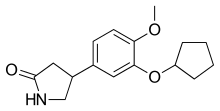Rolipram
Rolipram is a selective phosphodiesterase-4 inhibitor discovered and developed by Schering AG as a potential antidepressant drug in the early 1990s.[2] It served as a prototype molecule for several companies' drug discovery and development efforts.[3]:668ff Rolipram was discontinued after clinical trials showed that its therapeutic window was too narrow; it could not be dosed at high enough levels to be effective without causing significant gastrointestinal side effects.[3]:668
 | |
| Clinical data | |
|---|---|
| ATC code |
|
| Legal status | |
| Legal status |
|
| Pharmacokinetic data | |
| Bioavailability | 75%[1] |
| Metabolism | Liver via CYP2C8, CYP2C9, CYP2C19 and CYP2D6[1] |
| Elimination half-life | 3 hours[1] |
| Excretion | Urine (80%)[1] |
| Identifiers | |
| |
| CAS Number | |
| PubChem CID | |
| IUPHAR/BPS | |
| DrugBank | |
| ChemSpider | |
| UNII | |
| KEGG | |
| ChEBI | |
| ChEMBL | |
| CompTox Dashboard (EPA) | |
| ECHA InfoCard | 100.057.046 |
| Chemical and physical data | |
| Formula | C16H21NO3 |
| Molar mass | 275.348 g·mol−1 |
| 3D model (JSmol) | |
| |
| |
| | |
Rolipram has several activities that make it a continuing focus for research. The etiology of many neurodegenerative diseases involves misfolded and clumped proteins which accumulate in the brain. Cells have a mechanism to dispose of such proteins called the proteasome. However, in Alzheimer's disease and some other conditions the activity of these proteasomes is impaired leading to a buildup of toxic aggregates. Research in mice suggests that rolipram has the ability to ramp up the activity of proteasomes and reduce the burden of these aggregates. Preliminary evidence suggests that this can improve spatial memory in mice engineered to have aggregate build-up.[4] Rolipram continues to be used in research as a well-characterized PDE4 inhibitor.[3]:669 It has been used in studies to understand whether PDE4 inhibition could be useful in autoimmune diseases,[5] Alzheimer's disease,[6] cognitive enhancement,[7] spinal cord injury,[8] and respiratory diseases like asthma and COPD.[9]
See also
References
- Krause, W; Kühne, G; Sauerbrey, N (1990). "Pharmacokinetics of (+)-rolipram and (−)-rolipram in healthy volunteers". European Journal of Clinical Pharmacology. 38 (1): 71–75. doi:10.1007/BF00314807. PMID 2328751.
- Zhu, J; Mix, E; Winblad, B (Winter 2001). "The antidepressant and antiinflammatory effects of rolipram in the central nervous system". CNS Drug Reviews. 7 (4): 387–98. doi:10.1111/j.1527-3458.2001.tb00206.x. PMC 6741679. PMID 11830756.
- McKenna, JM and Muller, GW. Medicinal Chemistry of PDE4 Inhibitors. Chapter 33 in Cyclic Nucleotide Phosphodiesterases in Health and Disease, Eds Joseph A. Beavo et al. CRC Press, Dec 5, 2006 ISBN 9781420020847
- Myeku, Natura (December 21, 2015). "Tau-driven 26S proteasome impairment and cognitive dysfunction can be prevented early in disease by activating cAMP-PKA signaling". Nature Medicine. 22 (1): 46–53. doi:10.1038/nm.4011. PMC 4787271. PMID 26692334.
- Kumar N, et al. (Apr 2013). "Phosphodiesterase 4-targeted treatments for autoimmune diseases". BMC Med. 11 (1): 96. doi:10.1186/1741-7015-11-96. PMC 3616808. PMID 23557064.
- García-Osta A, et al. (Nov 2012). "Phosphodiesterases as therapeutic targets for Alzheimer's disease". ACS Chem Neurosci. 3 (11): 832–44. doi:10.1021/cn3000907. PMC 3503343. PMID 23173065.
- Normann C, Berger M (Nov 2008). "Neuroenhancement: status quo and perspectives". Eur Arch Psychiatry Clin Neurosci. 258 (Suppl 5): 110–4. doi:10.1007/s00406-008-5022-2. PMID 18985306.
- Hannila SS, Filbin MT (Feb 2008). "The role of cyclic AMP signaling in promoting axonal regeneration after spinal cord injury". Exp Neurol. 209 (2): 321–32. doi:10.1016/j.expneurol.2007.06.020. PMC 2692909. PMID 17720160.
- Huang Z, Mancini JA (2006). "Phosphodiesterase 4 inhibitors for the treatment of asthma and COPD". Curr. Med. Chem. 13 (27): 3253–62. doi:10.2174/092986706778773040. PMID 17168849.